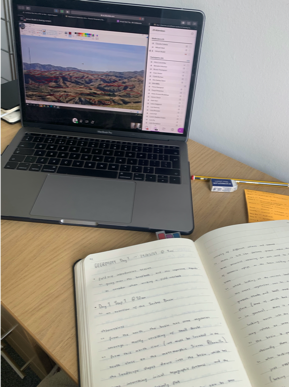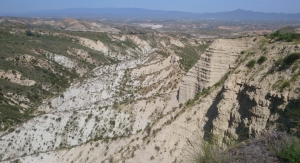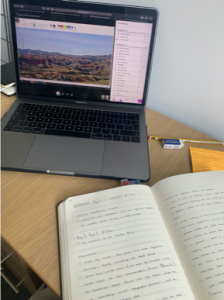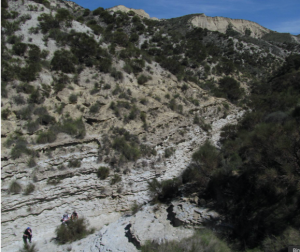Experiencing a virtual field-trip

By Erin, BSc Geography
Hybrid and online learning over the past year has had its ups and downs for all students throughout University. Whether it be at home or in Edinburgh, everyone has adapted to the changes in learning and in life in general differently. One adaption – which for most geoscience students will have been a particularly difficult one – is the changes made to field-trips.
Almost every geoscience student will experience some form of field-trip at one point in their degree, most of us can’t get enough of them to put it quite simply! Yet with the pandemic came the cancellation or reinvention of our trips.
The concept of a virtual field-trip was relatively new to me and those within my course. As BSc Geography students, we had experienced a few trips prior to the pandemic, but had high hopes for what was on the horizon. Coming into 3rd year, our second semester field course to Southern Spain seemed unlikely – but the department expressed its interest and excitement in regards to running the trip virtually.

Photo📷: Marine marl slopes present throughout the Almeria study site, highlighting the stark differences in vegetation coverage which was explored throughout the trip.
The content and the structure of the trip would be very much the same. We would meet at 9 the morning for activities and different tasks, followed by a lunch break and some more learning in the afternoon – but instead of being in the field, we would use various means of digital exploration.
Google earth, satellite imagery and remote sensing data, as well as photographs taken in the field on previous trips to the area were used to simulate a similar experience and exercises that would occur on the trip itself. This was conducted over Blackboard Collaborate in attempt to maintain the social and interactive aspects of a field-trip – the most important part I feel!

Photo📷: My field-trip desk set-up, sun cream and sunglasses not pictured!
The tasks and content of the trip were engaging, and staff encouraged active participation as they would in the field. We investigated a range of different concepts including; the differing geological and lithological impacts on river channels, plus their incision and tectonic uplift throughout history, and the wide variety of vegetation present throughout the landscape.
On our second day for example, we started by observing a range of Quaternary sediments which had infilled the Sorbas basin through time. These sediments had been photographed and we were able to make detailed interpretations of the processes which had led to their current state, such as fluvial erosion and different deposition events. With this, a broader understanding of the landscape as a whole could be understood, meaning we could link physical phenomenon such as incised alluvial fans and river terraces to the range of sediments present. Google Street view meant we were still able to walk the same routes within the valleys as we would on the trip – essentially the same experience just without the sunburn or Spanish sangria!
The 5-day long trip was concluded with some data collection and interpretation in small groups, which allowed for a more relaxed atmosphere as the trip was coming to a close. With a range of different options, I opted to investigate the changes to channel width with differing geologies and relating such to the drainage area. The group were able to collect over 100 channel width data points from a wide range of channels, much more than what would have been obtained in the field for the same timescale. The data was interpreted and visualised throughout QGIS, and overall the virtual collection of field data was favoured for this particular task as opposed to physically collecting data in the field.

Photo📷: An incised limestone river channel within the Sorbas Basin in Almeria, Southern Spain explored in previous trips and virtually.
Speaking to course mates, it was clear that although the week was long and intensive at times (sitting in front of a computer from 9-5 when you should actually be in Southern Spain catching a field-trip tan), we all thoroughly enjoyed the new learning experience. For the circumstances, the trip was planned and carried out with passion and dedication, something the School are incredibly proud of – and for students, this does not go unnoticed!
Overall, the virtual trip was a success! Daunting at first, the online experience ran smoothly, and although a little bit different to the usual type of field-trip, a similar set of field skills and knowledge were obtained. We can all agree that we would rather be out in the field (and hopefully that is the case soon) but the experience of a virtual field-trip is currently the next best thing – and for that we are incredibly grateful!
Follow us on Instagram or Twitter for more updates from our Geosciences students!



